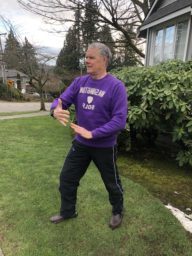 In about 2005 to improve my golf game I started to study Tai Chi from Master Yang Jun at Yang Family Tai Chi. I have been a student ever since. As well as the Long Form I study Push Hands. Below is an edited version (footnotes omitted but source cited) of an article I wrote for Yang Family Tai Chi on “The Ten Essentials” of Tai Chi and Golf.
In about 2005 to improve my golf game I started to study Tai Chi from Master Yang Jun at Yang Family Tai Chi. I have been a student ever since. As well as the Long Form I study Push Hands. Below is an edited version (footnotes omitted but source cited) of an article I wrote for Yang Family Tai Chi on “The Ten Essentials” of Tai Chi and Golf.
In golf, there are “certain actions that must take place during the act of hitting if the ball is to be struck with accuracy and power.” (Bobby Jones). The haphazard uninformed player may occasionally hit a decent shot but he cannot “hope to compete with the man whose sound swing carries him time after time into…[sound] position.” Id. The player with the sound swing – like the sound Tai Chi student- is the player who through countless hours masters movements that result in repeating proper form. It “is utterly impossible to play good golf without a swing that will repeat.” Id. The repeating swing is mastered through the repetition of fundamentals in form that are right because they produce quality shots under all kinds of pressure. Id.
As with Tai Chi, proper golf form requires specific moves done in a balanced, relaxed, and focused way. The essentials of Tai Chi are the same as the essentials of golf. Through practice and application of Tai Chi essentials, we reach a higher level of physical and mental form. An analysis of The Ten Essentials of Tai Chi reveals fundamentals that, if practiced, will lead to good Tai Chi form and good Golf form.
Light Energy at Top of Head. This first essential requires the head to be upright and straight. There must be no “strength” used so the neck and back remain relaxed and natural. This allows for the conscious intent to be natural and lively. Likewise, in golf the head must be erect with a feeling of naturalness. This feeling allows the golf player to be uninhibited. Tiger Woods stresses good posture. “One of the most important aspects of good posture is to hold your chin high at address.” With his back fairly straight and a bit of flex in his knees Tiger’s body is “prepared to move freely in any direction…” (Tiger Woods).
Sink Chest Raise Back. In Tai Chi, this means the chi (life energy) needs to stay in the back rather than flow into the chest which will cause top heaviness. Sinking the chest allows the chi to flow into the spine which creates strength in the spine. This also prevents the upper body from feeling heavy which results in poor form. In golf, for good form we also must eliminate any feeling of top-heaviness. Ben Hogan teaches that proper golf posture lies with the back being naturally erect. “Your upper trunk should feel like it’s an elevator dropping down a floor – the club head descends as your trunk descends.” This, as in Tai Chi, allows for movement and power to occur from the foundation of the feet.
Relax the Waist. In Tai Chi “the waist is the ruler of the body.” When the waist is relaxed the feet have power, and our foundation is stable. Movement of the waist leads to necessary change from full to empty. A relaxed waist allows for the transfer of power. According to Bobby Jones, the most important movement in golf is “to start the downswing by beginning the unwinding of the hips [waist].” As in Tai Chi, there can be no power or accuracy in golf unless a relaxed waist leads the downswing.
Distinguish Insubstantial from Substantial. In Tai Chi, the practitioner must be able to distinguish movement and weight transfer from left to right (called empty and full). When we can distinguish empty and full our turning movement becomes light, nimble and almost without effort. When we transfer weight we must stay within the foundation of our stance. Failure to distinguish weight transfer and stay within our foundation leads to an unsteady stance. In golf we must shift from our target side during the backswing to our non-target side before initiating the downswing when we shift back to our target side. When we shift our weight no part of the torso moves beyond the feet. This can only be done by distinguishing between insubstantial (moving away from the ball) to substantial (moving back and through the ball). As in Tai Chi, when we do this our swing is almost without effort.
Sink Shoulders Drop Elbows. Sinking the shoulders means relaxing the shoulders. They are allowed to hang down. Dropping the elbows means relaxing the elbows downward. This principle is also fundamental to the proper golf swing. This is what Ben Hogan is talking about when he says the upper trunk needs to have the feeling of dropping downward. Master Yang Jun continually teaches to “keep elbows down.” This essential fundamental is the same in the proper golf swing. The elbows must be down at the initiation of the swing. Hogan teaches the elbows must point to the hips which means to be down at address. The elbows must continue to remain down throughout the swing so the swing stays “connected.” This means the arms do not fly away from the body but are led by the body as they are in proper Tai Chi form.
Use Consciousness not Strength. Here we come to the higher level of both the Tai Chi form and the golf swing. This “means we must rely exclusively on mind and not on strength.” (Yang Jun). Superior Tai Chi form and golf form demands the body be loose and open to avoid “the slightest bit of crude force.” Id. Only by being soft are we able to obtain hardness. “No one can do it for you. You have to do it for yourself. It’s a matter of being in touch with yourself mentally, physically and emotionally.” Id. This is easier said than done. This fundamental is mastered by those at the highest level of Tai Chi and golf. It is the ability to move in the Tai Chi form and in the golf swing with fluidity – a natural uninhibited movement done without trying to aggressively hit the ball.
Unity of Upper and Lower Body. “The root is in the feet; it is issued through the legs, controlled by the waist and expressed in the hands.” Id. In Tai Chi and in golf, rooted feet provide a firm foundation which is necessary for stability allowing movement to initiate from the feet and progress upward.
The Unity of Internal and External. Here we learn in Tai Chi “[t]he spirit is the leader and the body is at its command.” Id. Thus, when the inner and outer are unified as one we have connection without interruption. This stands for the proposition that in proper Tai Chi form both the mind and the body are unified. The same is true for proper golf form. Percy Bloomer, a British golf professional, instructor, writes good golf form has both physical and mental components: “[W]e never act purely psychologically or purely physically … every act is carried out in psychophysical unison.” When this unison is properly functioning there is “conscious control” – a balance between mind and body – which is what is necessary for proper golf form and proper Tai Chi form.
Continuity Without Interruption. This fundamental continues to emphasize the mind. In Tai Chi, proper form requires the mind to be present to control the urge to use strength in an external clumsy way. Proper form requires there be no interruption. We must be “complete and continuous, circular and unending.” In golf, this fundamental means proper form requires “Rhythm.” As stated by Percy Boomer, rhythm is “flowing motion.” It is the continuous movement coordinated by mind and muscle to do the right form at the right time. As in Tai Chi, Boomer teaches slow continuous movement beats force every time. Boomer explains to be rhythmic we must use our mind to control the urge to hit too soon at the ball (called hitting from the top) As in Tai Chi, this early urge to use excess force results in clumsy non-rhythmic form. Continuity without interruption is thus required to achieve the rhythm necessary for proper form in the golf swing.
Seek Stillness in Movement. This fundamental recognizes that in Tai Chi there is movement but it is a movement in a slow, evenly paced form. Here Tai Chi is contrasted from the outward martial art forms such as Karate. Golf like Tai Chi is a slow moving sport. It is unlike rapid sports that rely on bursts of energy. Superior golf form demands a controlled even pace throughout the “round of golf.” As Tiger Woods says, “my creative mind is my greatest weapon.” Slow paced focused movement in Tai Chi leads to good form. In golf good form requires having a natural rhythm and routine, and focusing solely on what needs to be accomplished. We do this by seeking stillness in movement.
I continue to practice and develop in the Tai Chi form and in the Golf form. I work on form accepting the results. The greatest pleasure is the pursuit of the best possible form. This continued pursuit – the means – is a life long quest. The result – the end – will take care of itself. As for golf the pursuit of the best form is enhanced through the application of The Tai Chi Ten Essentials.

